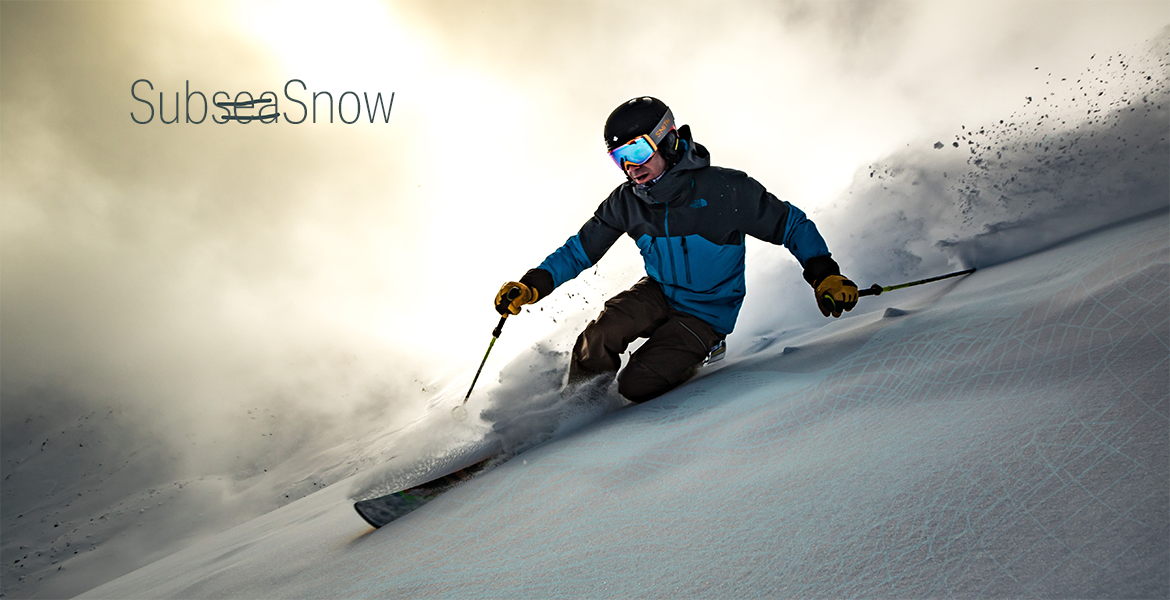Drop. Or not. The line looks perfect, but weak snow layers in steep angles makes avalanches a constant threat when exploring the backcountry. A few years down the line, an innovative ski-mounted radar may provide an extra layer of safety for the most daring skiers.
How is subsea and technology focused Head Energy Multicontrol playing a vital role in the development of a new ski-mounted radar system meant to increase safety for free- and Randonnée skiers? The answer is found in a Norwegian startup company called Think Outside and their innovative concept Sknow.
Searching for weak layers
The Sknow device itself resembles an iPod in shape and size. But while the latter was merely capable of playing audio files and now belongs to tech-history, the former analyzes the snow directly under your skis, while communicating with both a satellite (GPS) and your cellphone (Bluetooth) to present a geological snow profile on site.
It clicks on to the ski right in front of the binding and sends a radar signal through the layers of snow. The reflection is processed in real time – giving a detailed image of the surroundings. A LED light on the device lights up if unstable layers are detected.
“It is like having eyes under the snow”, Monica Vaksdal, CEO and founder of Think Outside told Powder.com in March 2019. Vaksdal has 16 years of experience as a geologist in the oil industry and with a lifelong passion for skiing, the idea had been brewing for some time before it was brought to life in the winter of 2018.

Software from scratch
Key to the Sknow development was both funding and experienced partners. Åsnes Ski, Norway´s largest Nordic backcountry ski producer has become official partner. The Sknow software is  programmed in collaboration with Senior Engineer Rolf Berge from Head Energy Multicontrol.
programmed in collaboration with Senior Engineer Rolf Berge from Head Energy Multicontrol.
Berge, more known for his sailing skills than steep-mountain free-skiing, has a technical background from both electronic and software design, and over twenty years of experience in design and implementation of embedded real-time systems. Although he has been mostly involved with subsea control systems in his time at Head Energy Multicontrol, he has previously participated in projects developing satellite landing systems, medical instruments, oceanographic instruments and consumer products.
Currently working on the 2.0 version of Sknow, Berge tells about the development process from his point of view:
-It is both fun and challenging. Fun in the sense that we are creating something new and groundbreaking, with a clear upside in making it easier to make good decisions outdoors. Challenging in the sense that there is a vision of how we want the Sknow to work, but no clear spec of the necessary features. It is still doable though, and we are progressing in accordance to plan, Berge tells.
Increased safety and experience
Lars Tveit Christiansen, geologist, avalanche expert and experienced skier, has made 5 field tests with the Sknow prototype, collecting data that is being used to create an algorithm that instantly analyzes snow-layers.
-We have collected recordings of the snow-layers. Currently, the data collected is not meaningful to the end user, but we are using it to train our machine learning algorithm. When we have gathered enough samples to fully train the model, the algorithm will provide a digital snow profile on site. Hopefully, this will improve decision-making and be an important addition for skiers, avalanche experts and tour guides. However, it will not replace manual analyzes in the field. Experience and know-how will still be the main assets, but Sknow offers highly valuable new information in the decision-making process, Christiansen says.
He also emphasizes that the smart-ski concept could add multiple experience features on top of the extra safety it provides:
-I think there are a lot of features that would make this a cool gadget as well. Let’s say you can log your descents directly on your smart phone, including snow details, angles, speed, altitude, lines et cetera. Combining the radar on your skis with GPS tracking would provide a much more accurate set of data than a regular smart-watch, and tailored from a skier’s point of view, instead of a multi-sport solution, Lars adds.

Engineering bandwidth
Head Energy Multicontrol got involved in the Sknow project through the OMNI Specialist Network. Managing Director, Trond Erik Gundersen, does not believe this project will be a one-off for the company:
-The OMNI Network provides access to some very interesting opportunities for us. Let us not forget that we are a subsea and technology focused company, hence our horizon is wider than the oil & gas industry. Our engineering staff is highly skilled, but also very passionate about tech-development and new solutions, so I think this is a good fit for us and something that we are going to get more involved in in the years to come. Rolf (Berge) is a great asset to us and has done brilliant, groundbreaking work on the Sknow project so far. We are excited about Think Outside and their project and very much look forward to seeing how this develops, Trond Erik Gundersen says.
